文章目錄
- 1.3 Node.js 的應用場景(附案例與代碼實現)
- 1.3 Node.js 的應用場景(附案例與代碼實現)
- 一、Web 服務器開發
- 二、API 開發
- 三、命令行工具(CLI)開發
- 四、實時應用開發
- 小結
1.3 Node.js 的應用場景(附案例與代碼實現)
1.3 Node.js 的應用場景(附案例與代碼實現)
Node.js 憑借異步非阻塞 I/O和事件驅動的特性,在多個領域展現出高效性和靈活性。以下結合具體案例和可運行代碼,詳細介紹其典型應用場景:
一、Web 服務器開發
Node.js 原生支持 HTTP 模塊,可直接構建輕量級 Web 服務器,尤其適合處理高并發的靜態資源請求(如 HTML、CSS、圖片等)。
-
優勢:
- 單線程模型減少內存開銷,非阻塞 I/O 可同時處理 thousands 級并發連接(無需為每個請求創建新線程)。
- 配合
express等框架,可快速擴展為支持路由、中間件的完整服務器。
-
案例:靜態文件服務器
- 使用 Node.js 原生
http模塊和fs模塊,實現一個簡單的靜態文件服務器,根據請求路徑返回對應文件。 - server.js
// server.js const http = require('http'); const fs = require('fs'); const path = require('path'); // 創建 HTTP 服務器const server = http.createServer((req, res) => {// 解析請求路徑(默認返回 index.html)const filePath = req.url === '/' ? './public/index.html' : `./public${req.url}`;const extname = path.extname(filePath); // 獲取文件擴展名// 設置 Content-Type(簡單處理常見類型)const contentType = {'.html': 'text/html','.css': 'text/css','.js': 'text/javascript','.png': 'image/png'} [extname] || 'text/plain';// 讀取文件并返回fs.readFile(filePath, (err, data) => {if (err) {// 處理 404 錯誤res.writeHead(404, { 'Content-Type': 'text/html' });res.end('<h1>404 Not Found</h1>');} else {res.writeHead(200, { 'Content-Type': contentType });res.end(data); // 返回文件內容}}); });// 啟動服務器const PORT = 3000; server.listen(PORT, () => {console.log(`服務器運行在 http://localhost:${PORT}`); }); - index.html
// index.html <!-- public/index.html --> <!DOCTYPE html> <html> <head><meta charset="UTF-8"> <!-- 添加這行設置字符編碼為 UTF-8 --><title>Node.js 靜態服務器</title><link rel="stylesheet" href="style.css"> </head> <body> <div class="container"><h1>Hello Node.js Server</h1><p>這是一個由 Node.js 原生模塊構建的靜態文件服務器</p> </div> </body> </html> - style.css
/* public/style.css */ body {font-family: Arial, sans-serif;max-width: 800px;margin: 0 auto;padding: 20px;background-color: #f0f2f5; }h1 {color: #1a73e8;border-bottom: 2px solid #eee;padding-bottom: 10px; }p {line-height: 1.6;color: #333; }.container {background-color: white;padding: 30px;border-radius: 8px;box-shadow: 0 2px 4px rgba(0,0,0,0.1); }
- 使用 Node.js 原生
-
運行步驟:
-
- 創建目錄結構:
project/ ├── server.js └── public/├── index.html├── style.css└── image.png -
- 在
public/index.html中寫入簡單內容(如<h1>Hello Node.js Server</h1>)。
- 在
-
- 執行命令:
node server.js。
- 執行命令:
-
- 訪問
http://localhost:3000,可看到index.html內容;訪問http://localhost:3000/style.css可返回樣式文件。


- 訪問
-
二、API 開發
Node.js 是構建 RESTful API 或 GraphQL 接口的熱門選擇,尤其適合需要頻繁與數據庫、第三方服務交互的場景。
-
GraphQL 是一種用于 API 開發的查詢語言,與傳統 RESTful API 不同,它
允許客戶端精確指定需要獲取的數據,避免了過度獲取或獲取不足的問題。 -
簡單說,GraphQL 讓客戶端 “說了算”,想要什么數據就明確告訴服務器,避免了數據浪費或不夠用的問題,尤其適合前端需求多變的場景。
-
優勢:
- 異步編程模型完美適配 API 中的 “等待數據返回” 操作(如數據庫查詢、網絡請求),避免阻塞。
- 豐富的框架(如
Express、Koa)和庫(如Mongoose、Sequelize)簡化開發。 - 案例:RESTful 用戶 API
使用Express框架和內存數組模擬數據庫,實現用戶信息的增刪改查(CRUD)接口。 - api.js
// api.js const express = require('express'); const app = express(); app.use(express.json());// 模擬數據庫(用戶數組) let users = [{ id: 1, name: 'Alice', age: 25 },{ id: 2, name: 'Bob', age: 30 } ];// 新增:處理根路徑請求 app.get('/', (req, res) => {res.send(`<h1>用戶API服務</h1><p>可用接口:</p><ul><li>GET /api/users - 獲取所有用戶</li><li>GET /api/users/:id - 獲取單個用戶</li><li>POST /api/users - 創建用戶(需JSON請求體)</li><li>PUT /api/users/:id - 更新用戶</li><li>DELETE /api/users/:id - 刪除用戶</li></ul>`); });// 以下是原有的接口(保持不變) app.get('/api/users', (req, res) => {res.json(users); });app.get('/api/users/:id', (req, res) => {const user = users.find(u => u.id === parseInt(req.params.id));if (!user) return res.status(404).json({ message: '用戶不存在' });res.json(user); });app.post('/api/users', (req, res) => {const newUser = {id: users.length + 1,name: req.body.name,age: req.body.age};users.push(newUser);res.status(201).json(newUser); });app.put('/api/users/:id', (req, res) => {const user = users.find(u => u.id === parseInt(req.params.id));if (!user) return res.status(404).json({ message: '用戶不存在' });user.name = req.body.name || user.name;user.age = req.body.age || user.age;res.json(user); });app.delete('/api/users/:id', (req, res) => {const userIndex = users.findIndex(u => u.id === parseInt(req.params.id));if (userIndex === -1) return res.status(404).json({ message: '用戶不存在' });users.splice(userIndex, 1);res.json({ message: '用戶已刪除' }); });app.listen(3000, () => {console.log('API 服務器運行在 http://localhost:3000'); });
-
運行步驟:
-
- 安裝依賴:
npm install express。
- 安裝依賴:
-
- 執行命令:
node api.js。
- 執行命令:
-
- 使用工具(如 Postman、curl)測試接口:
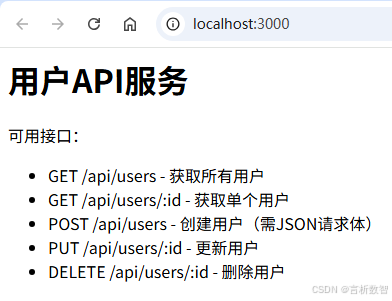
- 使用工具(如 Postman、curl)測試接口:
-
-
GET ``http://localhost:3000/api/users→ 獲取所有用戶。
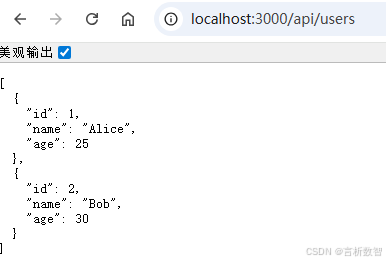
-
POST ``http://localhost:3000/api/users(請求體:{ "name": "Charlie", "age": 28 })→ 創建用戶。
三、命令行工具(CLI)開發
Node.js 可開發跨平臺(Windows/macOS/Linux)的命令行工具,用于自動化腳本、項目腳手架等場景。
-
優勢:
- 借助
commander(命令解析)、inquirer(交互式提問)等庫,快速實現命令行交互。 - 通過
npm發布后,用戶可全局安裝(npm install -g)并直接調用。
- 借助
-
案例:項目初始化工具
- 開發一個簡單的 CLI 工具,通過命令快速創建前端項目目錄(如
src、public文件夾及基礎文件)。 - cli.js
#!/usr/bin/env node // 聲明為 Node 可執行文件 const { program } = require('commander'); const fs = require('fs'); const path = require('path');// 定義命令:init <項目名> program.command('init <projectName>').description('創建新項目').action((projectName) => {// 創建項目目錄const projectPath = path.join(process.cwd(), projectName);if (fs.existsSync(projectPath)) {console.error(`錯誤:目錄 ${projectName} 已存在`);return;}fs.mkdirSync(projectPath);// 創建子目錄和文件const dirs = ['src', 'public'];dirs.forEach(dir => {fs.mkdirSync(path.join(projectPath, dir));});// 創建 index.htmlfs.writeFileSync(path.join(projectPath, 'public/index.html'),'<!DOCTYPE html>\n<html>\n<head>\n<title>My Project</title>\n</head>\n<body></body>\n</html>');console.log(`項目 ${projectName} 創建成功!路徑:${projectPath}`);});// 解析命令行參數 program.parse(process.argv);
- 開發一個簡單的 CLI 工具,通過命令快速創建前端項目目錄(如
-
運行步驟:
-
- 安裝依賴:
npm install commander。
- 安裝依賴:
-
- 在
package.json中添加配置(使工具可全局調用):
{"name": "my-cli","version": "1.0.0","bin": {"mycli": "./cli.js"},"dependencies": {"commander": "^11.0.0"} } - 在
-
- 本地鏈接工具:
npm link(相當于全局安裝)。
- 本地鏈接工具:
-
- 執行命令:
node cli.js init my-project→ 自動創建my-project目錄及結構。
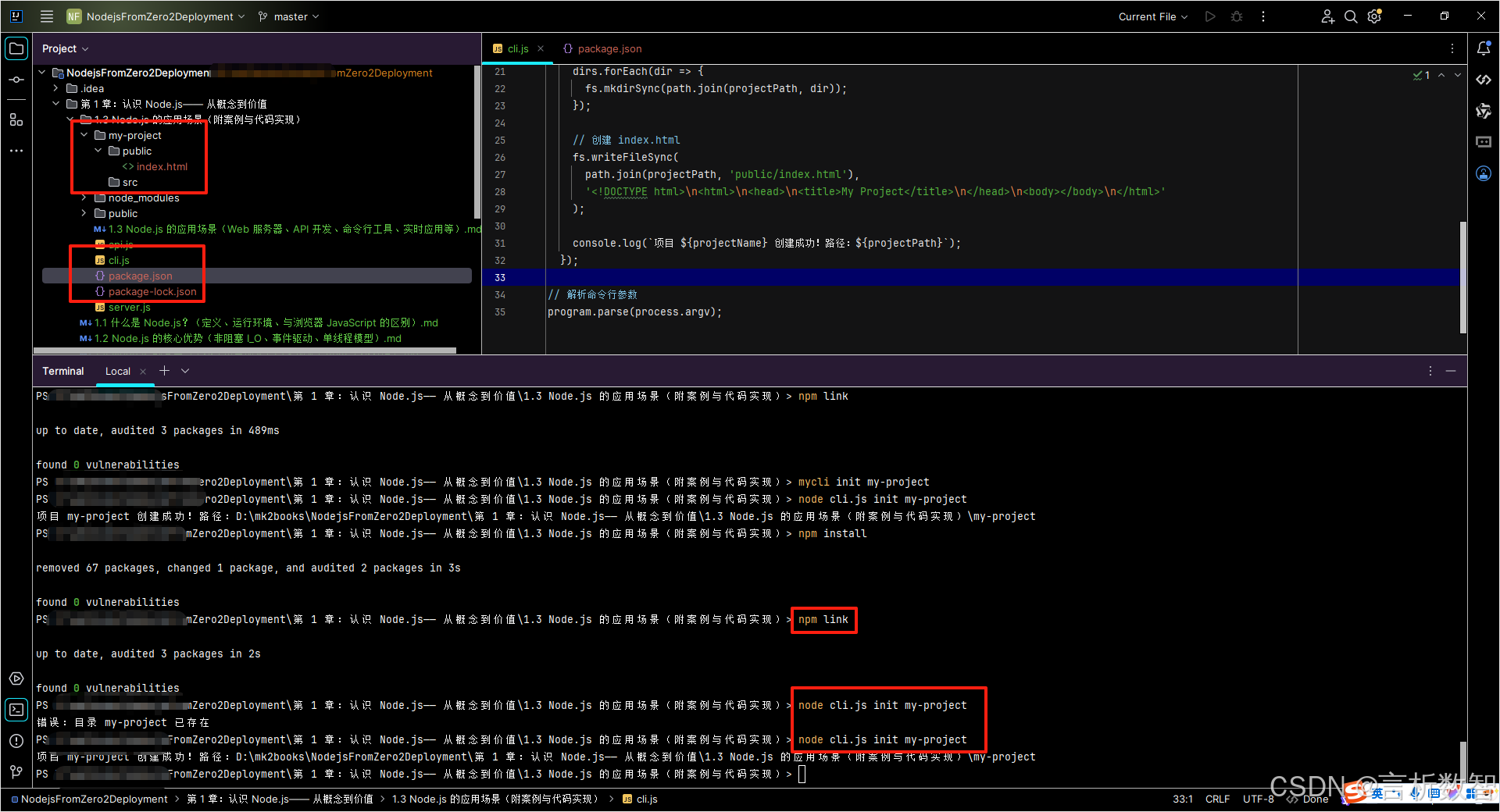
- 執行命令:
-
四、實時應用開發
Node.js 是實時通信應用的首選技術,其事件驅動模型可高效處理低延遲、高并發的雙向通信(如聊天室、實時協作工具)。
-
優勢:
-
基于
WebSocket協議(全雙工通信),配合ws或Socket.io庫,實現服務器與客戶端的實時數據推送。 -
案例:簡易 WebSocket 聊天室
- 使用
ws庫實現一個實時聊天室,支持多用戶同時發送和接收消息。
- 使用
-
websocket-server.js
// websocket-server.js const WebSocket = require('ws'); const wss = new WebSocket.Server({ port: 8080 }); // 創建 WebSocket 服務器// 存儲所有連接的客戶端 const clients = new Set();// 監聽客戶端連接 wss.on('connection', (ws) => {console.log('新客戶端連接');clients.add(ws);// 監聽客戶端消息ws.on('message', (data) => {const message = data.toString(); // 接收消息(字符串格式)console.log(\`收到消息:\${message}\`);// 廣播消息給所有客戶端(包括發送者)clients.forEach(client => {if (client.readyState === WebSocket.OPEN) {client.send(message); // 轉發消息}});});// 監聽客戶端斷開連接ws.on('close', () => {console.log('客戶端斷開連接');clients.delete(ws);}); });console.log('WebSocket 聊天室運行在 ws://localhost:8080'); -
客戶端頁面(client.html):
<!-- client.html --><!DOCTYPE html> <html> <head><meta charset="UTF-8"> <!-- 添加這行設置字符編碼為 UTF-8 --><title>Node.js 靜態服務器</title><link rel="stylesheet" href="style.css"> </head> <body><input type="text" id="messageInput" placeholder="輸入消息"> <button onclick="sendMessage()">發送</button> <div id="messages"></div> <script>// 連接 WebSocket 服務器const ws = new WebSocket('ws://localhost:8080');// 接收服務器消息ws.onmessage = (event) => {const messagesDiv = document.getElementById('messages');messagesDiv.innerHTML += `<p>${event.data}</p>`;};// 發送消息到服務器function sendMessage() {const input = document.getElementById('messageInput');const message = input.value;if (message) {ws.send(message);input.value = '';}}</script> </body> </html>
-
-
運行步驟:
-
- 安裝依賴:
npm install ws。
- 安裝依賴:
-
- 啟動服務器:
node websocket-server.js。
- 啟動服務器:
-
- 用瀏覽器打開多個
client.html頁面,在輸入框中發送消息,所有頁面會實時顯示消息內容。
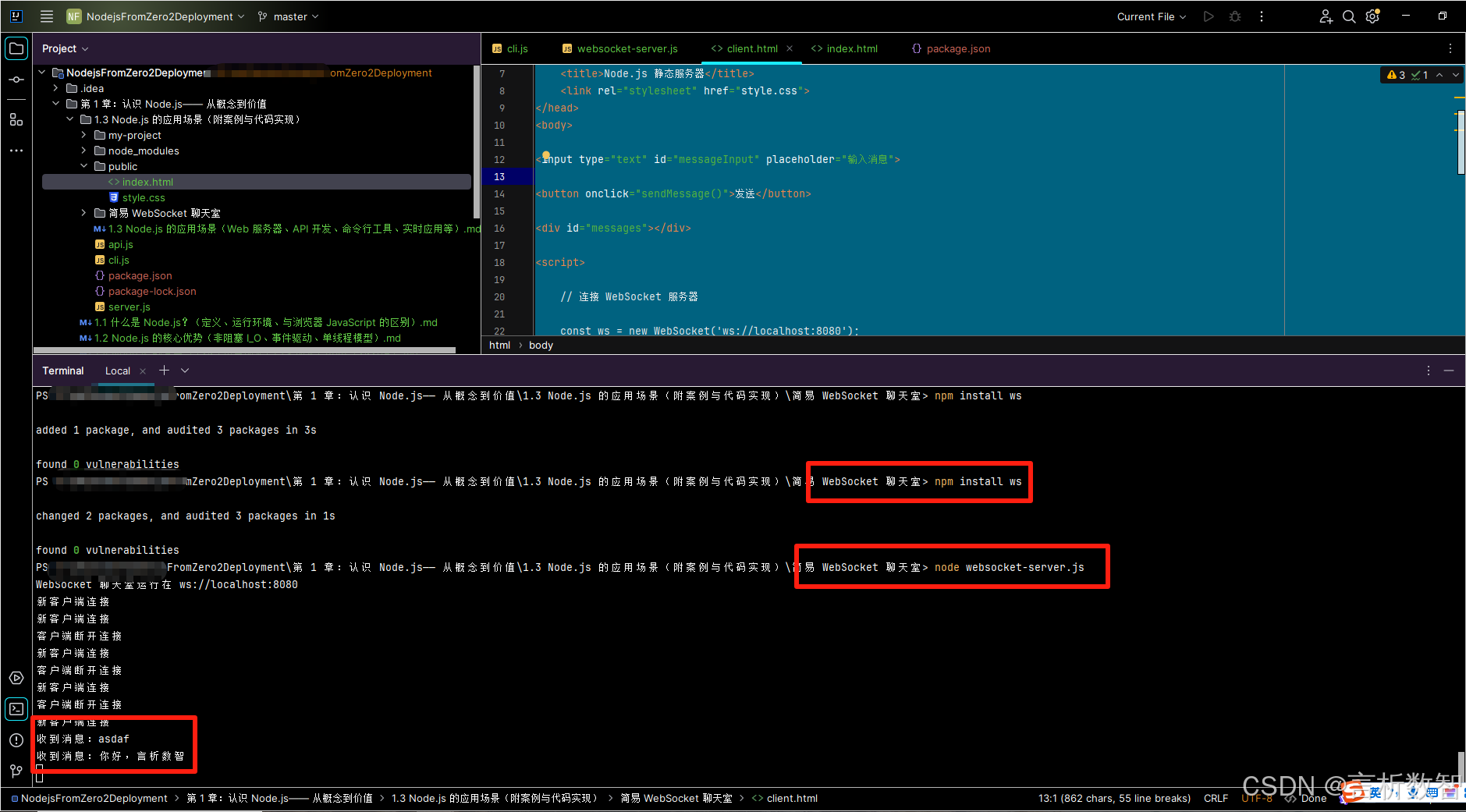
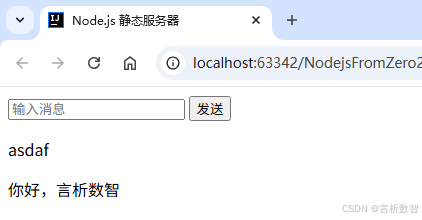
- 用瀏覽器打開多個
-
小結
Node.js 的應用場景遠不止上述幾類,還包括桌面應用開發(如
Electron)、數據流處理(如日志分析)、微服務架構等。
- 其核心優勢在于將 JavaScript 的靈活性與異步 I/O 結合,使開發者能高效應對各類場景,尤其是 I/O 密集型任務。
- 通過豐富的生態(npm 包、框架),Node.js 進一步降低了開發門檻,成為全棧開發的重要工具。









)


、resource() 和 prompt() 裝飾器)





:基于獎勵修正的強化學習視角)
Mac 終端上配置代理)